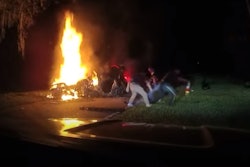Precisely one month ago—on May 24th, 2022—an 18-year-old gunman in Uvalde, Texas, shot his grandmother in the face and left her for dead.
He then took off in a pickup truck and crashed it in a dry culvert, abandoning the vehicle and opening fire on people outside a nearby funeral home. Next, he climbed a short fence surrounding Robb Elementary School and entered the building through a back door.
While inside, he shot and killed 19 children and two teachers. An additional 17 people were injured. It was the second-deadliest school shooting in U.S. history.
Fitts' Law and MMQB
In the immediate aftermath of the tragedy, rumors flew around like pigeons suddenly rousted from a rooftop roost. The grandmother was killed. She wasn't. The door was left "propped open" by a teacher. It wasn't. A police officer engaged the shooter before he entered the school. Never happened. Police officers "immediately breached" the building and "kept him pinned down." Well, not exactly.
The earliest reports from any incident such as the terrible attack in Uvalde last month are almost always incorrect, or at least inaccurate. This is in part due to Fitts' law, which states that the more accurate the task to be accomplished, the longer it takes. It will take many months to sort out what truly transpired, and we're not nearly done this discovery process just one month in.
However, at this juncture we do know that gunman was indeed "pinned down" and trapped in a classroom room.
The problem is that he was in there with an unknown number of victims—some certainly dead, some possibly dying, and some frantically (and furtively) placing phone calls to 911 pleading for assistance.
That assistance, as it turns out, was staged right outside the classroom doorway—for a prolonged period of time.
According to multiple reports, many of the officers on duty that day had participated in training on active shooter response just weeks before the massacre. That training was either insufficient or inadequate or simply not followed.
It's unclear—at least from publicly available sources—who conducted the most recent active shooter response training in Uvalde, who attended it, or what the curriculum was. The Texas Commission on Law Enforcement (TCOLE) guide for training conducted in 2020 states that doorways are "easy ambush points" and that dynamic entry should be used to "dominate the room" utilizing "speed, surprise, and violence of action."
By all currently available accounts, as many as 19 officers apparently stood in the hallway for nearly an hour, allegedly trying to find keys to unlock the door. Some reports indicate that the gunman could not have locked the classroom door from the inside, and investigators believe it may have been unlocked the whole time.
Furthermore, why there wasn't a Halligan tool or a battering bar at the scene remains to be seen—or, if one was there, why wasn't it used?
In addition, one can now safely surmise that there was—at minimum—significant breakdown the C3 system (command, control, and communication).
Pete Arredondo, police chief of the Uvalde School District, told the media he didn't believe himself to be the person in command at the scene, and that he had assumed someone else had taken control of the police response. Making matters worse, he reportedly shed both his agency and campus radios before entering the school thinking that this gear would "slow him down."
Lessons Learned Hard
Early reports that an off-duty Border Patrol agent whose wife is a teacher and his child a student at Robb Elementary borrowed his barber's shotgun, raced to the school, rushed inside, and killed the gunman were—wait for it—inaccurate.
Jacob Albarado did grab his barber's shotgun, go to the school, and help evacuate children emerging from the building—but he did not enter the school and he did not kill the suspect.
Evidently, a Border Patrol tactical team breached the classroom door and ended the threat.
It would be a fool's errand to paint the police response to the Uvalde massacre as anything resembling "successful." In fact, state investigation concluded earlier this month that the police response that day was an "abject failure."
Ian McCraw—head of the Texas State Police—said in releasing the report that "the only thing stopping the hallway of dedicated officers from entering room 111 and 112 was the on-scene commander."
Uvalde will be recorded in the annals of police history as a "teaching moment" much in the same manner as the Columbine massacre, which everyone in the business of training law enforcement thought had changed the way in which active shooter response was to be done.
Following Columbine, the model of "Immediate Reaction, Rapid Deployment (IARD)" became the SOP. No more waiting for a tactical team to assemble—just "run to the gun" and stop the threat.
For whatever reason, is seems apparent that the lessons learned hard in Colorado 23 years ago didn't exactly stick in Uvalde last month.
What will we learn this time for next time? Because there will—unfortunately, undoubtedly—certainly be a next time.
















